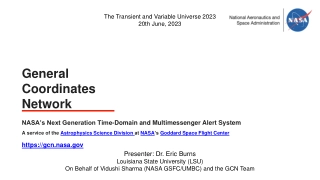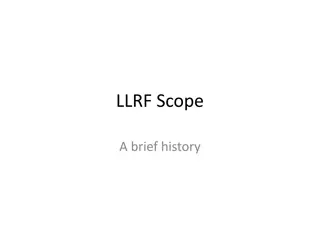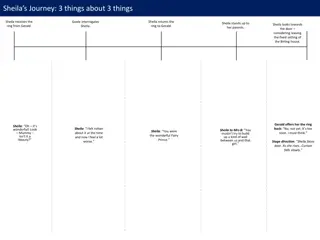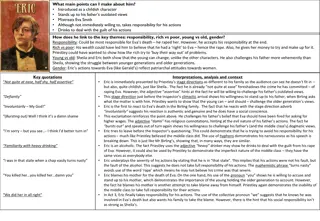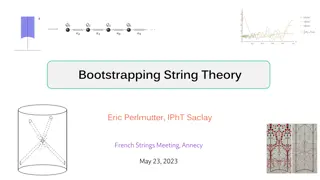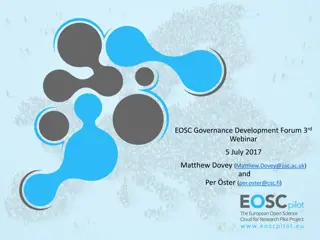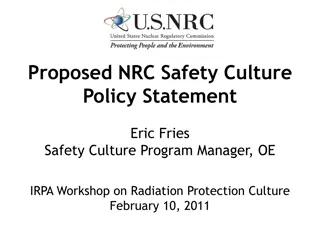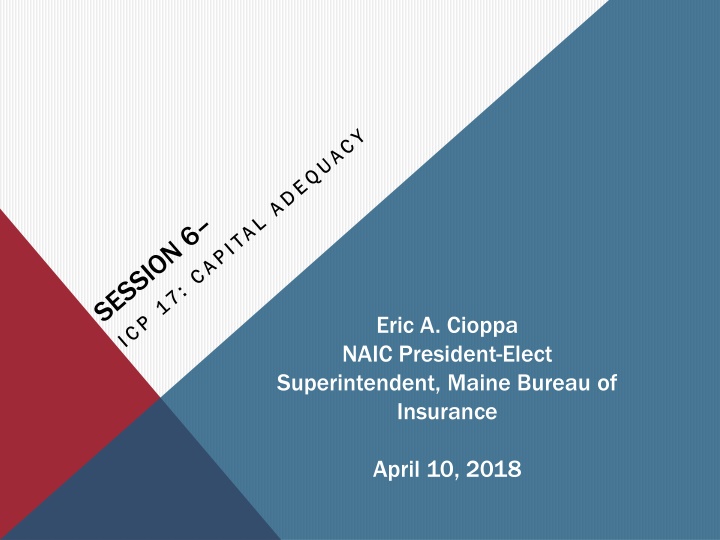
The U.S. Solvency Framework for Insurers
Explore the U.S. Solvency Framework focusing on regulatory reporting, disclosure, reserves, capital adequacy, and solvency requirements for insurers. Learn about risk-based capital ratios, action levels, and the importance of ongoing financial assessments.
Download Presentation

Please find below an Image/Link to download the presentation.
The content on the website is provided AS IS for your information and personal use only. It may not be sold, licensed, or shared on other websites without obtaining consent from the author. If you encounter any issues during the download, it is possible that the publisher has removed the file from their server.
You are allowed to download the files provided on this website for personal or commercial use, subject to the condition that they are used lawfully. All files are the property of their respective owners.
The content on the website is provided AS IS for your information and personal use only. It may not be sold, licensed, or shared on other websites without obtaining consent from the author.
E N D
Presentation Transcript
Eric A. Cioppa NAIC President-Elect Superintendent, Maine Bureau of Insurance A S S A L A S S A L April 10, 2018
U.S. SOLVENCY FRAMEWORK U.S. SOLVENCY FRAMEWORK 1. 1. Heavy emphasis on reporting and disclosure Used in the continual assessment of risk Standardized reporting allows comparability Drive offsite and onsite monitoring More information requested when needed Used with internal company information Regulatory Reporting, Disclosure and Transparency Regulatory Reporting, Disclosure and Transparency 2. 2. Assess on an on-going basis the financial condition of the insurer (quarterly) Identify/assess current and prospective risks Automated financial analysis tools Use any information to help understand the company and its actions (SEC filings, market conduct reports, rate and policy form filings, consumer complaints, rating agency reports, media) Used to determine need for, and scope of, targeted exams Continual loop between analysis and exam Off Off- -Site Monitoring and Analysis Site Monitoring and Analysis 3. 3. Full scope exam performed at least once every 5 years Focus on the ability of company controls and processes to limit current and prospective solvency risk Include a review of corporate governance and ERM processes Develop detailed findings and recommendations to communicate to company and to assist in ongoing analysis process If issues exist, more frequent full scope or targeted exams occur On On- -Site Risk Site Risk- -Focused Examinations Focused Examinations 2
U.S. SOLVENCY FRAMEWORK U.S. SOLVENCY FRAMEWORK Reserves, Capital Adequacy and Reserves, Capital Adequacy and Solvency Solvency Requirements in place for insurers to utilize credentialed actuaries to issue an opinion on the company s reported reserves Deficient reserves /rapid growth/underpricing=50% of insolvencies (P&C and health) PBR effective 1/1/17 for about 20 companies, another 150 expected 1/1/20, could change this Historically life reserves overly conservative XXX/AXXX created reserves 3 to 4 times cash flows/GAAP reserves Resulted in the creation of captives, however, less of an issue that elimination of the products, which is occurring in other countries where requirements are too stringent Risk-Based Capital (RBC) requires capital based upon the specific risks of the insurer (asset, underwriting, reserving) as opposed to fixed dollar amounts (which still exist as minimum start-up capital) 4. 4. RBC RBC Ratio Ratio Action Level Action Level Description Description >301% No Action Required N/A 201% - 300% Trend Test Level Act as if CAL triggered 151% - 200% Company Action Level (CAL) Company submits an RBC Action Plan 101% - 150% Regulatory Action Level Commissioner may order specific corrective actions 71% - 100% Authorized Control Level May place insurer under regulatory control 70% Mandatory Control Level Must place insurer under regulatory control 3
LIFE INDUSTRY NET INCOME, LIFE INDUSTRY NET INCOME, REALIZED CAPITAL G(L), OPERATING INCOME, ROA REALIZED CAPITAL G(L), OPERATING INCOME, ROA 4
CAPITAL & SURPLUS, ROE CAPITAL & SURPLUS, ROE Industry C&S and ROE $400 15% 12.4% 11.8% 8.9% 10.9% 9.7% 9.2% 8.3% 6.8% 3.8% $300 5% In Billions $200 -5% $100 -15% (21.2)% $0 -25% 2007 2008 2009 2010 2011 2012 2013 2014 2015 2016 End C&S** ROE ** Adjusted to exclude direct and indirect affiliated llfe amounts 5
LIFE RBC LIFE RBC AGGREGATED Life RBC DATA YR2016 YR2016 718 # OF COMPANIES FILED RBC AUTHORIZED CONTROL LEVEL RBC (AFTER DIVERSIFICATION) 53,371,992,970 53,371,992,970 Total C0 (Asset risk-affiliates) 19,961,695,520 19,961,695,520 Total C1CS (Asset risk-common stock) 26,649,848,001 26,649,848,001 Total C1O (Asset risk-Other) 42,489,721,515 42,489,721,515 Total C2 (Insurance risk) 24,540,625,751 24,540,625,751 Total C3a (Interest rate risk) Total C3c (Market risk) (C3b not listed as immaterial for health credit risk) 15,229,088,812 15,229,088,812 2,208,998,999 2,208,998,999 Total C4a (Business risk) 7,747,940,544 7,747,940,544 6 Total C4b (Business risk Admin Expenses) 649,189,658 649,189,658
U.S. SOLVENCY FRAMEWORK U.S. SOLVENCY FRAMEWORK 5. 5. Certain significant broad-based transactions require separate treatment Licensing Requirements Gateway to business Investment Limitations Risk to company s assets Change in Control - Can impact strategy & direction Extraordinary Dividends Release of capital Transactions with Affiliates Subject to abuse Reinsurance Often material and subject to abuse Regulatory Control of Significant, Broad Regulatory Control of Significant, Broad- -based Risk based Risk- -related Transactions/Activities related Transactions/Activities 6. 6. In addition to authority granted through RBC, U.S. supervisors have broad authority to require corrective action when a hazardous condition is identified Corrective examples include: Requiring the insurer to file interim financial reports Reducing, suspending or restricting the volume of business being accepted or renewed by the insurer Limiting or withdrawing the insurer from certain investments or investment practices Preventive and Corrective Measures, Including Enforcement Preventive and Corrective Measures, Including Enforcement 7. 7. Receivership law examples include: Mergers, acquisitions, reinsurance Arrangements, non-renewal of part or all of the insurer s book of business Allowing the insurer to be placed in run-off mode under its own management Priority of claims and guaranty funds Exiting the Market and Receivership Exiting the Market and Receivership 7
RISK RISK- -FOCUSED SURVEILLANCE FOCUSED SURVEILLANCE 8
SOLVENCY MONITORING ACTIVITIES SOLVENCY MONITORING ACTIVITIES Insurers Seeking Approval for Insurers Seeking Approval for Transactions/Events Transactions/Events ~ 2,300 entities ~ 2,300 entities Subject to: Regulatory Review of Licensing, Acquisitions, Dividends, Affiliate Agreements, Reinsurance Contracts, Product/Rate Filings Peer Review of Solvency Peer Review of Solvency Monitoring Monitoring ~ 30 entities ~ 30 entities Subject to: Review of analysis/exam work by teams of peers Insurers Exceeding Premium Insurers Exceeding Premium Thresholds Thresholds ~ 2,000 entities ~ 2,000 entities Subject to: ORSA Reporting & Analysis Enhanced Audit Requirements All U.S. Insurers All U.S. Insurers ~ 4,600 entities ~ 4,600 entities Subject to: AS & Supplemental Filings RBC Reporting/Requirements FAST Review Level 1 Analysis IPS & Supervisory Plan Nationally Significant Nationally Significant Insurers Insurers ~ 1,400 entities ~ 1,400 entities Subject to: Additional review, analysis and consideration through FAWG process Accreditation Review of Accreditation Review of Solvency Monitoring Solvency Monitoring ~ 120 entities ~ 120 entities Subject to: Review of exam/analysis and licensing work by a team of independent experts Troubled/Potentially Troubled Troubled/Potentially Troubled Insurers Insurers ~ 200 ~ 200 - - 400 entities 400 entities Subject to: Detailed FAWG Review Discovery Meetings Presentations and Reporting Insurers Undergoing Insurers Undergoing Examinations Examinations ~ 1,150 entities ~ 1,150 entities Subject to: Review & Assessment of CG/ERM Review of Critical Risks Reporting Findings 10
Group Supervision Group Supervision 10
GROUP CAPITAL CALCULATION GROUP CAPITAL CALCULATION In late 2015, the NAIC began exploring potential approaches to a G Group based insurance and in 2016, formed the Group Capital Calculation (E) Working Group. roup C Capital apital C Calculation (GCC alculation (GCC) rooted in the national system of state- RBC RBC Basis for the calculation will use a risk-based capital aggregation methodology. o An inventory method will be used that provides for a carrying value and capital requirement amount for each entity in the group. Additional regulatory tool Additional regulatory tool - The GCC is not intended to be an ICS or group capital requirement, but is a tool for regulators and may help inform such discussions and developments. Goals and objectives of the GCC Goals and objectives of the GCC: o Valuable analytical tool to complement the US current holding company analysis. o Assists the group supervisor in monitoring the overall financial flexibility and strength of the group as a whole. o Quantitative measure to be used by regulators in conjunction with group-specific risks and stresses identified in ORSA and Form F filings that may not be captured in legal entity RBC filings. Scope Scope of the GCC of the GCC Initially will include all legal entities within the group. Once calculation is developed, the Working Group may consider if it is not appropriate for certain groups and entities within the group. GCC GCC Timeline Timeline: o Tentative timeline has been established, but no strict deadlines at this point o The timeline includes two iterations of field testing in order to evaluate and fine-tune the calculation The tentative timeline anticipates the GCC being implemented during 2019 or 2020, after referral to the appropriate NAIC groups for incorporation into the NAIC toolkit o 11
ORSA ORSA The NAIC Risk Management and Own Risk and Solvency Assessment Model Act (RMORSA) went into effect January 1, 2015. Two primary goals Two primary goals o Foster effective level of ERM for all insurers o Provide group-level perspective on risk and capital Principle Principle- -based based requirements requirements Implementation Implementation o ORSA Model has been adopted by nearly all U.S. jurisdictions and nationwide adoption is expected by the end of 2017 o U.S. is requesting the group-ORSAs filed with foreign group-wide supervisors to gain deeper understanding. 2017 ORSA Findings 2017 ORSA Findings o More than 300 reports expected in total (approximately 200 at group level, 100 legal-entity only), excluding international premium data o ORSA provides new and valuable information for U.S. regulators o ORSA forces insurers to be more disciplined around risk management 12
ANY QUESTIONS? ANY QUESTIONS? 13

